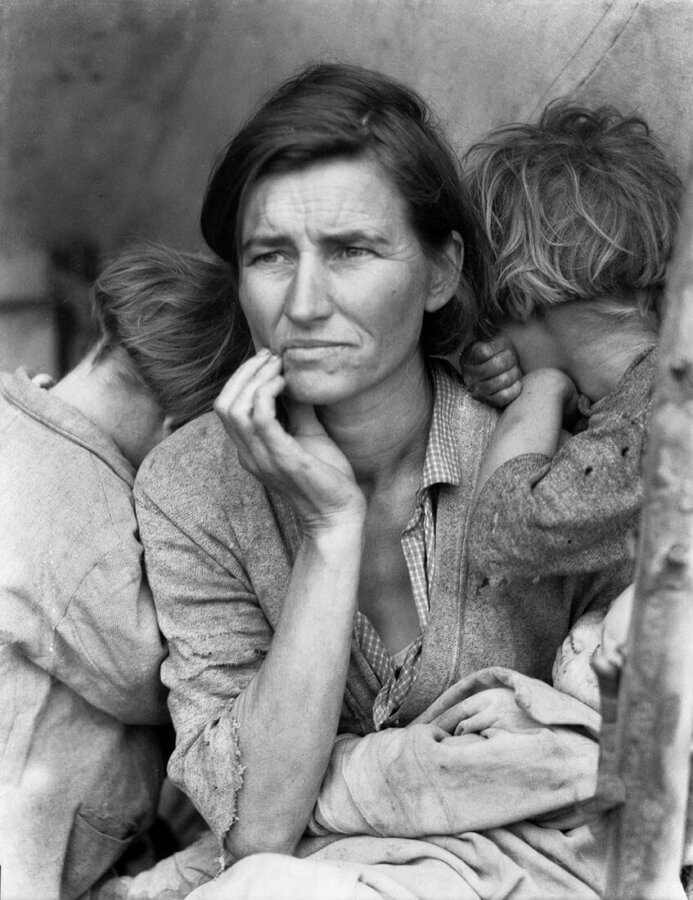
Exhibition
Dorothea Lange
Politics of Seeing
From 16 October 2018 to 27 January 2019
Jeu de Paume – Paris
Watch the video portrait of the exhibition:
The Politics of Seeing features major works by the world famous American photographer Dorothea Lange (1895, Hoboken, New Jersey–1966, San Francisco, California), some of which have never before been exhibited in France. The exhibition focuses on the extraordinary emotional power of Dorothea Lange’s work and on the context of her documentary practice. It features five specific series: the Depression period (1933-1934), a selection of works from the Farm Security Administration (1935-1939), the Japanese American internment (1942), the Richmond shipyards (1942-1944) and a series on a Public defender (1955-1957). Over one hundred splendid vintage prints taken between 1933 and 1957 are enhanced by the presence of documents and screenings broadening the scope of an œuvre often familiar to the public through images such as White Angel Breadline (1933) and Migrant Mother(1936), which are icons of photographic history.
The majority of prints in this exhibition belong to the Oakland Museum of California, where Lange’s
considerable archive, donated to the museum after her death by her husband Paul Shuster Taylor,
is conserved.
Like John Steinbeck’s famous novel The Grapes of Wrath, Dorothea Lange’s œuvre has helped shape our conception of the interwar years in America and contributed to our knowledge of this period. However, this exhibition also introduces other aspects of Dorothea Lange’s practice, which she herself considered archival. By placing the photographic work in the context of her anthropological approach, it enables viewers to appreciate how its power also lies in her capacity to
interact with her subjects, evident in her captions to the images. She thereby considerably enriched the informative quality of the visual archive and produced a form of oral history for future generations.
In 1932, during the Great Depression that began in 1929, Lange observed the unemployed homeless
people in the streets of San Francisco and decided to drop her studio portrait work because she felt
that it was no longer adequate. During a two-year period that marked a turning point in her life, she took photographs of urban situations that portrayed the social impact of the recession. This new work became known in artistic circles and attracted the attention of Paul Schuster Taylor, professor of economics at the University of California, Berkeley. Taylor was a specialist in agricultural conflicts of the 1930s, and in particular Mexican migrant workers. He began using Lange’s photographs to illustrate his articles and in 1935 they started working together for the government agencies of the New Deal. Their collaboration lasted for over thirty years.
During the Second World War, Lange continued to practise photography and to document the major
issues of the day, including the internment of Japanese-American families during the war; the economic and social development due to industries engaged in the war effort; and the criminal justice system through the work of a county public defence lawyer.
Dorothea Lange’s iconic images of the Great Depression are well known, but her photographs of Japanese-Americans interned during the Second World War were only published in 2006. Shown here for the first time in France, they illustrate perfectly how Dorothea Lange created intimate and poignant images throughout her career in order to denounce injustices and change public opinion.
In addition to the prints, a selection of personal items, including contact sheets, field notes and publications allow the public to situate her work within the context of this troubled period.
The exhibition at the Jeu de Paume offers a new perspective on the work of this renowned American
artist, whose legacy continues to be felt today. Highlighting the artistic qualities and the strength
of the artist’s political convictions, this exhibition encourages the public to rediscover the importance of Dorothea Lange’s work as a landmark in the history of documentary photography.
Curators: Drew Heath Johnson, Oakland Museum of California, Alona Pardo and Jilke Golbach, Barbican Art Gallery, Pia Viewing, Jeu de Paume.
Exhibition organized by the Oakland Museum of California.
The European presentation has been produced in collaboration with Barbican Art Gallery, London
and Jeu de Paume, Paris.
The exhibition is supported in part by the Oakland Museum Women’s Board, the Henry Luce Foundation, the Susie Tompkins Buell Fund, and Ann Hatch and Paul Discoe.
The Neuflize OBC Bank, historic sponsor of the Jeu de Paume,
and FIDAL chose to bring their support for the exhibition “Dorothea Lange. Politics of Seeing” in Paris.
This exhibition is made possible through a contribution from the Terra Foundation for American Art.
